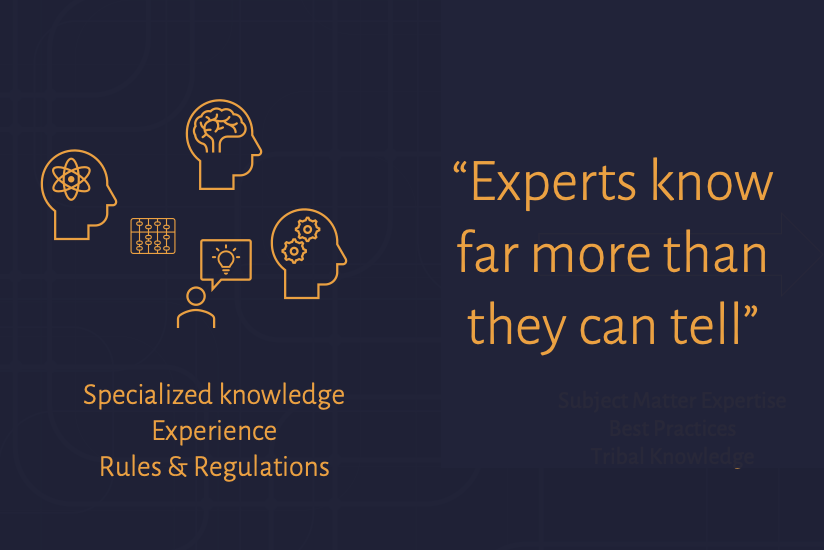Knowledge is one of the most valuable assets within an organization, yet much of it remains tacit—deeply embedded in the experience, intuition, and problem-solving abilities of subject matter experts (SMEs). Unlike explicit knowledge, which can be easily documented in manuals and databases, tacit knowledge is highly contextual, often unstructured, and difficult to extract using traditional methods.
PICK’s knowledge capture framework is built on principles from cognitive science, expert systems research, and human-computer interaction, leveraging psychologically informed techniques and AI-driven methodologies to make the process as intuitive, efficient, and comprehensive as possible.
The Psychology of Expert Knowledge Transfer
The process of transferring expertise has been widely studied in cognitive psychology and knowledge management. Research shows that experts often struggle to articulate what they intuitively “know,” a phenomenon called the “expert blind spot” or “unconscious competence”. The challenge is that expertise is often procedural, deeply embedded in pattern recognition, and difficult to break down into discrete steps.
To address this, PICK incorporates structured interviewing techniques and AI-guided prompting, designed to:
- Overcome the expert blind spot → AI dynamically prompts experts with structured and open-ended questions, adapting in real time based on responses.
- Surface procedural knowledge → AI-guided interviews encourage SMEs to break down their reasoning processes, mirroring techniques used in cognitive task analysis.
- Capture contextual knowledge → PICK not only records responses but analyzes patterns, decision trees, and contextual variables to preserve how and why decisions are made.
AI-Driven Cognitive Modeling: Extracting Tacit Knowledge
Traditional methods of knowledge capture—such as surveys, documentation, or even structured interviews—often fail to elicit deep expertise because they rely on explicit recall.
PICK enhances this process using AI-driven cognitive modeling techniques, influenced by:
- The Delphi Method → An iterative process where experts refine knowledge collectively, reducing bias and improving clarity.
- Think-Aloud Protocols → Encouraging experts to verbalize their thought processes, which PICK captures and structures dynamically.
- Natural Language Processing & Sentiment Analysis → Identifies confidence levels, uncertainty, and areas of hesitation in responses, allowing for deeper follow-up questions.
Through this multi-layered approach, PICK is able to capture not just facts, but reasoning, workflows, and decision-making heuristics—all critical components of true expertise.
How AI Mimics the Cognitive Process of Experts
To ensure that captured knowledge is not just recorded but made useful, PICK applies principles of semantic memory organization, inspired by:
- Schema Theory → Organizing knowledge in structured frameworks, allowing for intuitive retrieval and application.
- Chunking & Hierarchical Knowledge Representation → Structuring expertise in logical, bite-sized components that can be recombined for complex queries.
- Conceptual Mapping & Association Strength → PICK understands relationships between ideas, similar to how the human brain categorizes expertise.
This allows PICK to transform raw interviews into structured, contextualized knowledge graphs, ensuring that expertise is not just stored but retrievable in a way that aligns with how humans naturally recall information.
Multi-Modal Knowledge Capture: Going Beyond Text
Expertise often extends beyond spoken or written explanations—it is also found in demonstrations, workflows, and environmental interactions. PICK enhances its knowledge capture through:
- AI-Powered Video & Image Analysis → Identifies and tags critical steps in procedural knowledge.
- Pattern Recognition in Expert Decision-Making → Tracks key variables used by SMEs when making complex judgments.
- Adaptive Learning Models → PICK refines knowledge capture over time, learning from past interviews and responses.
This multi-modal approach ensures that knowledge is not lost in translation, preserving expertise as a living, evolving resource that can be retrieved and applied dynamically.
Conclusion: Moving Beyond Traditional Knowledge Management
PICK’s psychologically grounded, AI-driven approach to knowledge capture ensures that organizations are not just recording information—they are preserving expertise in a way that enhances decision-making, drives automation, and fuels long-term innovation.
By leveraging cognitive science, natural language processing, and AI-guided reasoning, PICK provides the most advanced, scalable solution for transforming tacit expertise into actionable intelligence.



